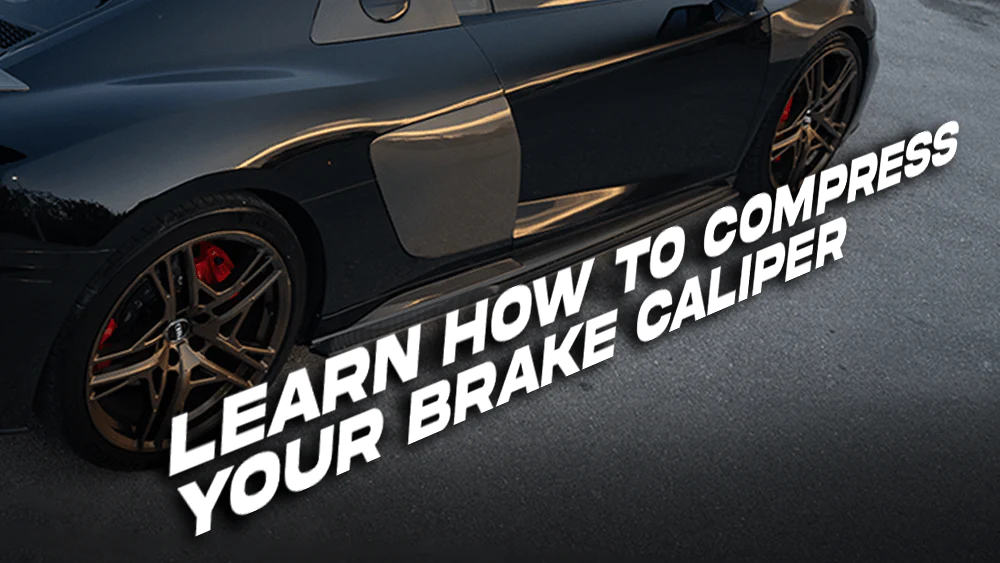
Brake calipers are an essential component of any vehicle, and knowing how to compress them is a crucial skill for any DIY mechanic. Without proper compression, it’s impossible to remove or replace brake pads, leading to reduced brake performance and potential safety hazards on the road. In this guide, we’ll explore how to compress your brake caliper safely and effectively, ensuring your vehicle’s brakes are functioning at their best.
Why You Need to Compress Your Brake Caliper
When replacing the brake pads or rotors on your vehicle, you must first compress the brake caliper. This is necessary because new brake pads are thicker than worn-out ones, making them incompatible with a fully extended caliper. Compressing the caliper pushes the piston back into the caliper, allowing enough clearance to install the new pads.
Failure to properly compress the caliper can result in uneven braking, premature wear and tear on your brake system, and even brake failure. When compressing the caliper, it’s important to use the proper tools and techniques to avoid damaging the caliper or brake system. In the next section, we’ll take you through the steps to safely and effectively compress your brake caliper.
Tools You Need to Compress Your Brake Caliper
To compress your brake caliper, you’ll need a few basic tools:
- C-clamp: A C-clamp is the most commonly used tool for compressing brake calipers. It works by squeezing the piston back into the caliper using leverage. To use a C-clamp, place the end with the screw over the caliper piston and the other end against the back of the caliper. Then, tighten the screw until the piston is fully compressed.
- Pliers: Sometimes, the piston on the caliper has to be rotated or twisted while being compressed. In such a case, pliers can be used to twist and push the piston inwards. However, pliers may not be the best option for all vehicles, and it’s essential to make sure they won’t damage the caliper.
- Brake caliper compression tool: These specialized tools are designed to compress brake calipers without damaging the piston or the caliper. They are easy to use and work for most modern sets of brakes.
The C-clamp and pliers can effectively compress the brake caliper, but they have the potential to damage the caliper. If you are unsure of which tool to use, consult your vehicle’s manual or consult with a professional mechanic. And always make sure the tool fits the caliper correctly and that you are using it according to the manufacturer’s instructions.
How to Compress Your Brake Caliper
Now that you know the importance of compressing your brake caliper and the tools you need, let’s take a look at the step-by-step process of compressing your brake caliper.
Step #1: Gather the Necessary Tools
Make sure you have all the necessary tools on hand, including a C-clamp, pliers, or a brake caliper compression tool. Also, put on your safety gear, including gloves, goggles, and appropriate clothing.
Step #2: Loosen the Brake Caliper Bolts
Loosen the brake caliper bolts with a wrench, gently tugging it out of the way once it’s loose. This will give you the space you need to remove your brake pads and compress your brake caliper.
Step #3: Remove the Brake Pads
Remove the brake pads from the caliper by gently sliding them out. Place them aside, being careful not to damage them.
Step #4: Compress the Brake Caliper
Place the C-clamp or brake caliper compression tool over the piston and the back of the caliper, depending on the tool you’re using. Slowly turn the C-clamp or use the compression tool so that the piston is pressed back into the caliper, creating space for your new brake pads.
Step #5: Install the New Brake Pads
Put in your new brake pads, making sure they fit snugly into the caliper. They should easily slide into the space you created when compressing the caliper.
Step #6: Reassemble the Brake System
Place the brake caliper back over the rotor and tighten the bolts. Double-check that there are no loose parts and that everything is in place correctly. Finally, start your car to test your brakes thoroughly before hitting the road.
Compressing your brake caliper may seem intimidating, but with the right tools and steps, it’s a simple process that can help ensure the safety of you and your passengers. Always wear safety gear, be patient, and take your time when completing this task.
Tips for Compressing Your Brake Caliper
While compressing your brake caliper is a pretty straightforward process, it’s still important to follow some essential tips to ensure a safe and effective job.
- Use the Correct Tool for Your Vehicle: Different calipers require specific tools, so make sure to check your vehicle’s manual or with a professional to avoid damaging your brake system.
- Check the Brake Fluid Level: When compressing your brake caliper, the brake fluid level will rise toward the top of the master cylinder. Always make sure not to overfill it, as it can lead to further brake damage.
- Use the Right Amount of Force: Be careful not to use too much force when compressing the caliper, as this can cause damage to the brake system. Use the right amount of force and follow the proper technique to get the desired results.
- Clean the Caliper and Rotor: Before compression, ensure that the brake caliper and rotor are clean and free of debris. Dirt and debris will prevent the caliper from compressing completely, which can lead to uneven braking.
- Inspect the Brake Pads: Take the time to check the condition of your brake pads while compressing the caliper. If they’re excessively worn, consider replacing them. And don’t forget to also check the brake rotors while you’re at it.
By following these tips, you can safely and efficiently compress your brake caliper, ensure proper brake performance, and avoid potential safety hazards.
Upgrade Your Ride with TPT Foreign’s Custom Brake Caliper Services!
Are you ready to take your ride to the next level? Now that you know how to compress your brake caliper, it’s time to consider upgrading your brakes. At TPT Foreigns, we offer a range of high-quality brake caliper customization options, including painting, powder coating, and wrapping services.
Our team of experienced professionals will work with you to find the perfect custom design for your brake calipers, making your ride stand out from the crowd. We use only the highest quality materials and the latest techniques to ensure that your custom brake calipers look amazing and perform even better.
With TPT Foreigns, customizing your brake calipers has never been easier or more affordable. So why wait? Contact us today to learn more about our custom brake caliper services and take your ride to the next level!
Bottom Line
Compressing your brake caliper is a crucial skill for any DIY mechanic or car owner. The process ensures proper brake maintenance, allowing you to replace your brake pads and rotors or perform other necessary repairs safely and effectively. Throughout the article, we’ve covered the importance of compressing your brake caliper, provided a list of necessary tools, and detailed step-by-step instructions on how to compress your brake caliper. We’ve also shared tips to make the process easier and safer.
Properly compressing your brake caliper is an essential step in maintaining your vehicle’s brakes’ safety and efficiency. Don’t forget to wear safety gear to protect yourself while working on your brakes. Always follow the manufacturer’s instructions and use the recommended tools for your vehicle to avoid damaging your brake system. With the right tools, technique, and knowledge, you can complete this task in no time and keep you and your passengers safe on the road.
